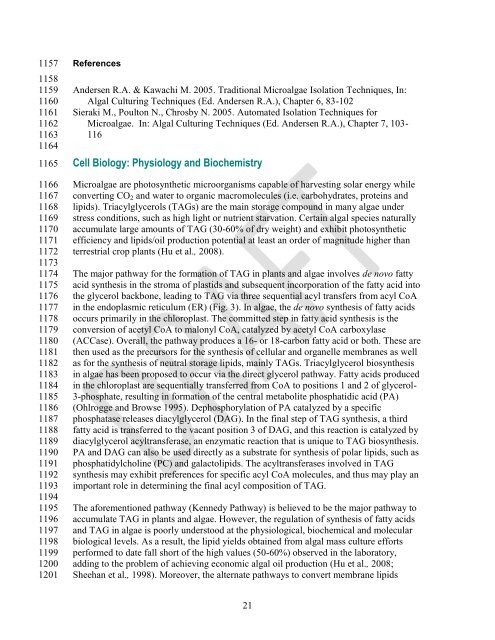Download the Algal Biofuels Roadmap draft document - Sandia
Download the Algal Biofuels Roadmap draft document - Sandia
Download the Algal Biofuels Roadmap draft document - Sandia
Create successful ePaper yourself
Turn your PDF publications into a flip-book with our unique Google optimized e-Paper software.
1157<br />
1158<br />
1159<br />
1160<br />
1161<br />
1162<br />
1163<br />
1164<br />
1165<br />
1166<br />
1167<br />
1168<br />
1169<br />
1170<br />
1171<br />
1172<br />
1173<br />
1174<br />
1175<br />
1176<br />
1177<br />
1178<br />
1179<br />
1180<br />
1181<br />
1182<br />
1183<br />
1184<br />
1185<br />
1186<br />
1187<br />
1188<br />
1189<br />
1190<br />
1191<br />
1192<br />
1193<br />
1194<br />
1195<br />
1196<br />
1197<br />
1198<br />
1199<br />
1200<br />
1201<br />
References<br />
Andersen R.A. & Kawachi M. 2005. Traditional Microalgae Isolation Techniques, In:<br />
<strong>Algal</strong> Culturing Techniques (Ed. Andersen R.A.), Chapter 6, 83-102<br />
Sieraki M., Poulton N., Chrosby N. 2005. Automated Isolation Techniques for<br />
Microalgae. In: <strong>Algal</strong> Culturing Techniques (Ed. Andersen R.A.), Chapter 7, 103-<br />
116<br />
Cell Biology: Physiology and Biochemistry<br />
Microalgae are photosyn<strong>the</strong>tic microorganisms capable of harvesting solar energy while<br />
converting CO2 and water to organic macromolecules (i.e. carbohydrates, proteins and<br />
lipids). Triacylglycerols (TAGs) are <strong>the</strong> main storage compound in many algae under<br />
stress conditions, such as high light or nutrient starvation. Certain algal species naturally<br />
accumulate large amounts of TAG (30-60% of dry weight) and exhibit photosyn<strong>the</strong>tic<br />
efficiency and lipids/oil production potential at least an order of magnitude higher than<br />
terrestrial crop plants (Hu et al., 2008).<br />
The major pathway for <strong>the</strong> formation of TAG in plants and algae involves de novo fatty<br />
acid syn<strong>the</strong>sis in <strong>the</strong> stroma of plastids and subsequent incorporation of <strong>the</strong> fatty acid into<br />
<strong>the</strong> glycerol backbone, leading to TAG via three sequential acyl transfers from acyl CoA<br />
in <strong>the</strong> endoplasmic reticulum (ER) (Fig. 3). In algae, <strong>the</strong> de novo syn<strong>the</strong>sis of fatty acids<br />
occurs primarily in <strong>the</strong> chloroplast. The committed step in fatty acid syn<strong>the</strong>sis is <strong>the</strong><br />
conversion of acetyl CoA to malonyl CoA, catalyzed by acetyl CoA carboxylase<br />
(ACCase). Overall, <strong>the</strong> pathway produces a 16- or 18-carbon fatty acid or both. These are<br />
<strong>the</strong>n used as <strong>the</strong> precursors for <strong>the</strong> syn<strong>the</strong>sis of cellular and organelle membranes as well<br />
as for <strong>the</strong> syn<strong>the</strong>sis of neutral storage lipids, mainly TAGs. Triacylglycerol biosyn<strong>the</strong>sis<br />
in algae has been proposed to occur via <strong>the</strong> direct glycerol pathway. Fatty acids produced<br />
in <strong>the</strong> chloroplast are sequentially transferred from CoA to positions 1 and 2 of glycerol-<br />
3-phosphate, resulting in formation of <strong>the</strong> central metabolite phosphatidic acid (PA)<br />
(Ohlrogge and Browse 1995). Dephosphorylation of PA catalyzed by a specific<br />
phosphatase releases diacylglycerol (DAG). In <strong>the</strong> final step of TAG syn<strong>the</strong>sis, a third<br />
fatty acid is transferred to <strong>the</strong> vacant position 3 of DAG, and this reaction is catalyzed by<br />
diacylglycerol acyltransferase, an enzymatic reaction that is unique to TAG biosyn<strong>the</strong>sis.<br />
PA and DAG can also be used directly as a substrate for syn<strong>the</strong>sis of polar lipids, such as<br />
phosphatidylcholine (PC) and galactolipids. The acyltransferases involved in TAG<br />
syn<strong>the</strong>sis may exhibit preferences for specific acyl CoA molecules, and thus may play an<br />
important role in determining <strong>the</strong> final acyl composition of TAG.<br />
The aforementioned pathway (Kennedy Pathway) is believed to be <strong>the</strong> major pathway to<br />
accumulate TAG in plants and algae. However, <strong>the</strong> regulation of syn<strong>the</strong>sis of fatty acids<br />
and TAG in algae is poorly understood at <strong>the</strong> physiological, biochemical and molecular<br />
biological levels. As a result, <strong>the</strong> lipid yields obtained from algal mass culture efforts<br />
performed to date fall short of <strong>the</strong> high values (50-60%) observed in <strong>the</strong> laboratory,<br />
adding to <strong>the</strong> problem of achieving economic algal oil production (Hu et al., 2008;<br />
Sheehan et al., 1998). Moreover, <strong>the</strong> alternate pathways to convert membrane lipids<br />
21


